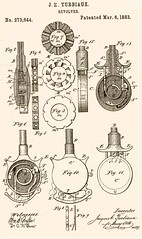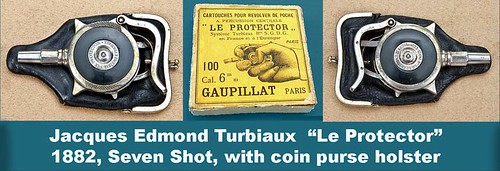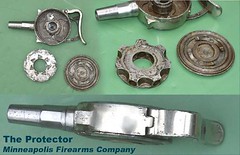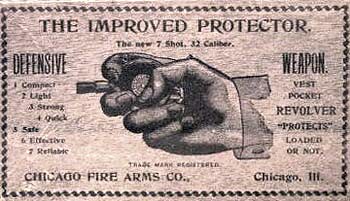Part the Third – how it got there
Recently, I have been blogging about the famous Parisian gang, the Apaches and about some of their hardware. In this episode I will talk about an interesting pistol that originated in France and was also made in the US. Although fairly rare, I am surprised at the number of all models of Palm Squeezers that appear. It tells me that they were kept clean, safe, and secret for many years.
Jacques Edmond Turbiaux was a Parisian inventor who patented a very unusual gun in 1882 in several European countries and the US a year later. It was unusual even in a time of innovation and excess. The pistol was not gun shaped and designed to be concealed easily, even when fired, yet be fully ergonomic and then slip right into a pocket. The key to this was to toss away the traditional cylinder and make a sort of metal doughnut that had chambers that radiated out from the center. The striker remained stationary at the center and the doughnut rotated around an axis, setting up each shot. The whole pistol fit in the palm of your hand and a short, secretive barrel that protruded between the fingers discretely. The gun was double action only, so no external cocking was necessary outside of the squeeze necessary to put all of this in motion.
 You could draw your gun discretely, literally palming it without drawing any attention to yourself. The diminutive barrel slightly protruding from between the fingers could be easily overlooked, especially in a crowd. In theory it was a defensive gun, in fact Turbiaux called it “The Protector”, but it also worked great for assassins or for criminals.
You could draw your gun discretely, literally palming it without drawing any attention to yourself. The diminutive barrel slightly protruding from between the fingers could be easily overlooked, especially in a crowd. In theory it was a defensive gun, in fact Turbiaux called it “The Protector”, but it also worked great for assassins or for criminals.
Reloading required rotating the cover one-quarter turn and removing the doughnut. Each chamber would need to be cleared of empty brass, if necessary, and fresh cartridges inserted. Then the process would be reversed. This is not a gun for a gunfight, nor was it accurate beyond a few feet due to the short barrel. In fact, there were no sights of any kind. I was made for short distances only and the relatively weak cartridge meant that you had to shoot for vital organs or the head to kill instantly. The French model was made in 6mm and 8mm central fire.
The American company, The Minneapolis Firearms Company, purchased the American rights to produce Turbiaux’s Le Protector and began production in 1891, ultimately producing 3,000 over the course of two years. Actual manufacture was done at a plant owned by James Duckworth of Springfield Mass. This was a seven shot .32 short caliber pistol that fired by squeezing the gun in the palm, compressing the handle, cocking the gun, rotating the doughnut firing chamber and firing the gun all in one motion.
 The Chicago Firearms Company bought the patent form the Minneapolis Firearms Company in 1892 and produced 12,800 examples of the peculiar pistol form 1894 through 1896. This model had a refinement of having an added safety catch that looked much like a trigger on the front of the gun, which the earlier Minneapolis and French gun lacked. The Chicago model also had a seven in its doughnut cylinder. These guns were manufactured by the Ames Sword Company of Chicopee Falls, Mass. The first models were supposed to be delivered in time to show at the Chicago World’s Fair, but Ames defaulted and was sued by The Chicago Firearms Company. Ames lost the suit and paid a substantial sum and became the owner of 12,800 pistols they did not want. They were sold on the market as late as 1910 in some cases, although all of them were made before 1898. These models were larger than the petit Minneapolis Firearms Company pistol because they were made as ten shot models (larger doughnut) rather than the earlier seven shot models of the previous company, although in the same caliber.
The Chicago Firearms Company bought the patent form the Minneapolis Firearms Company in 1892 and produced 12,800 examples of the peculiar pistol form 1894 through 1896. This model had a refinement of having an added safety catch that looked much like a trigger on the front of the gun, which the earlier Minneapolis and French gun lacked. The Chicago model also had a seven in its doughnut cylinder. These guns were manufactured by the Ames Sword Company of Chicopee Falls, Mass. The first models were supposed to be delivered in time to show at the Chicago World’s Fair, but Ames defaulted and was sued by The Chicago Firearms Company. Ames lost the suit and paid a substantial sum and became the owner of 12,800 pistols they did not want. They were sold on the market as late as 1910 in some cases, although all of them were made before 1898. These models were larger than the petit Minneapolis Firearms Company pistol because they were made as ten shot models (larger doughnut) rather than the earlier seven shot models of the previous company, although in the same caliber.
The strange story of a bizarre gun which emigrates from Apache ridden Paris to the new world and finally to Chicago was one fraught with patents, broken contracts and dubious uses for this funny little gun. I have handled a few over the years and they fit comfortably and quite substantially in the hand. They were covered nickel plate, or less commonly steel blue and the side plates could made with hard vulcanized rubber inserts or mother of pearl. This gun started out as a protector but also fell into the hands of criminals and gained a quirky reputation among collectors. It’s a true testament of Victorian arts and design and one that might be encountered in Call of Cthulhu games both in the New World and in Europe from the late 1890s through the 1930s or in Steampunk.
CoastConFan
See also my blog entries: APACHES ... IN PARIS? and APACHES IN PARIS? PART II for the first two parts of the series, plus an article on the Le Mat revolver called STEAMPUNK MINICANNONS ARE REAL .
CoastConFan
See also my blog entries: APACHES ... IN PARIS? and APACHES IN PARIS? PART II for the first two parts of the series, plus an article on the Le Mat revolver called STEAMPUNK MINICANNONS ARE REAL .



Is this still legal at the present time to carry with a carry permit ?
ReplyDeleteI really don't know, but I expect it might vary with the issuing state in the US. In any case these little palm squeezers are too scarce and too expensive to carry and the weak cartridge is not very effective at all. They were not very common and probably sold more as a curio than as an effective defense.
Delete